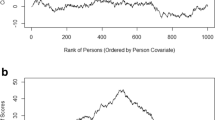Abstract
With random assignment to treatments and standard assumptions, either a one-way ANOVA of post-test scores or a two-way, repeated measures ANOVA of pre- and post-test scores provides a legitimate test of the equal treatment effect null hypothesis for latent variable Θ. In an ANCOVA for pre- and post-test variablesX andY which are ordinal measures ofη and Θ, respectively, random assignment and standard assumptions ensure the legitimacy of inferences about the equality of treatment effects on latent variable Θ. Sample estimates of adjustedY treatment means are ordinal estimators of adjusted post-test means on latent variable Θ.
Similar content being viewed by others
References
Brunk, H. D. (1965).An introduction to mathematical statistics. Blaisdell, MA: Blaisdell.
Davison, M. L., & Sharma, A. R. (1988). Parametric statistics and levels of measurement.Psychological Bulletin, 104, 137–144.
Davison, M. L., & Sharma, A. R. (1990). Parametric statistics and levels of measurement: Factorial designs and multiple regression.Psychological Bulletin, 107, 394–400.
Huck, S. W., & McClean, R. A. (1975). Using a repeated measures ANOVA to analyze the data from a pretest-posttest design: A potentially confusing task.Psychological Bulletin, 82, 511–518.
Lord, F. M. (1967). A paradox in the interpretation of group comparisons.Psychological Bulletin, 68, 304–305.
Luce, R. D., Krantz, D. H., Suppes, P., & Tversky, A. (1990).Foundations of measurement (Vol. 3). New York: Academic Press.
Maxwell, S. E., & Delaney, H. D. (1985). Measurement scales and statistics: An examination of variable validity.Psychological Bulletin, 97, 85–93.
Mitchell, J. (1986). Measurement scales and statistics: A clash of paradigms.Psychological Bulletin, 100, 398–407.
Mosteller, F., & Tukey, J. W. (1977).Data analysis and regression: A second course in statistics. Reading, MA: Addison-Wesley.
Porter, A. C., & Raudenbush, S. W. (1987). Analysis of covariance: Its model and use in psychological research.Journal of Counseling Psychology, 34, 383–392.
Suppes, P. (1959). Measurement, empirical meaningfulness, and three-valued logic. In C. W. Churchman & P. Ratoosh (Eds.),Measurement: Definitions and theories (pp. 129–143). New York: Wiley.
Townsend, J. T., (1990). Truth and consequences of ordinal differences in statistical distributions: Toward a theory of hierarchical inference.Psychological Bulletin, 108, 551–567.
Townsend, J. T., & Ashby, F. G. (1984). Measurement scales and statistics: The misconception misconceived.Psychological Bulletin, 96, 394–401.
Author information
Authors and Affiliations
Rights and permissions
About this article
Cite this article
Davison, M.L., Sharma, A.R. ANOVA and ANCOVA of pre- and post-test, ordinal data. Psychometrika 59, 593–600 (1994). https://doi.org/10.1007/BF02294394
Received:
Revised:
Issue Date:
DOI: https://doi.org/10.1007/BF02294394




